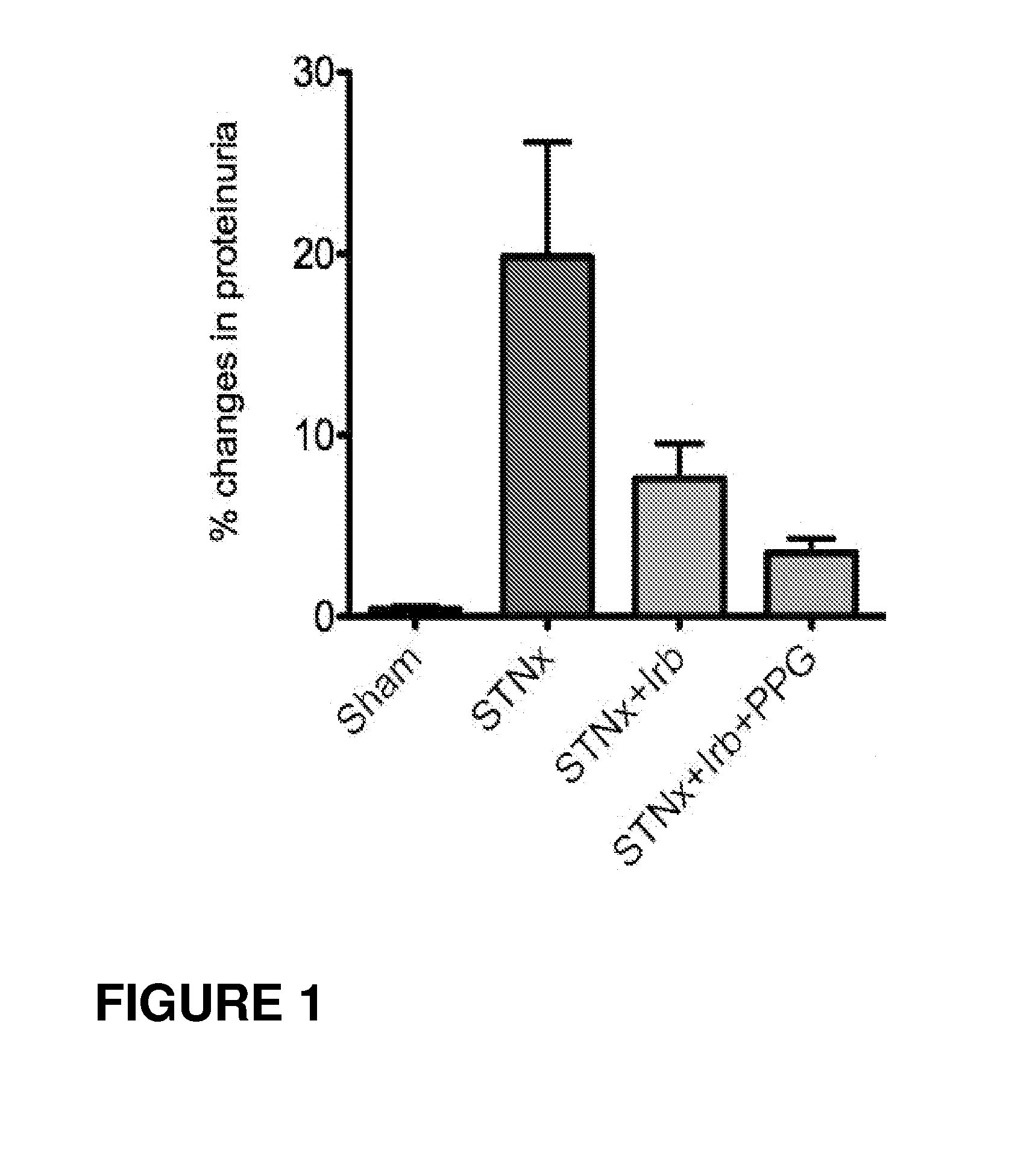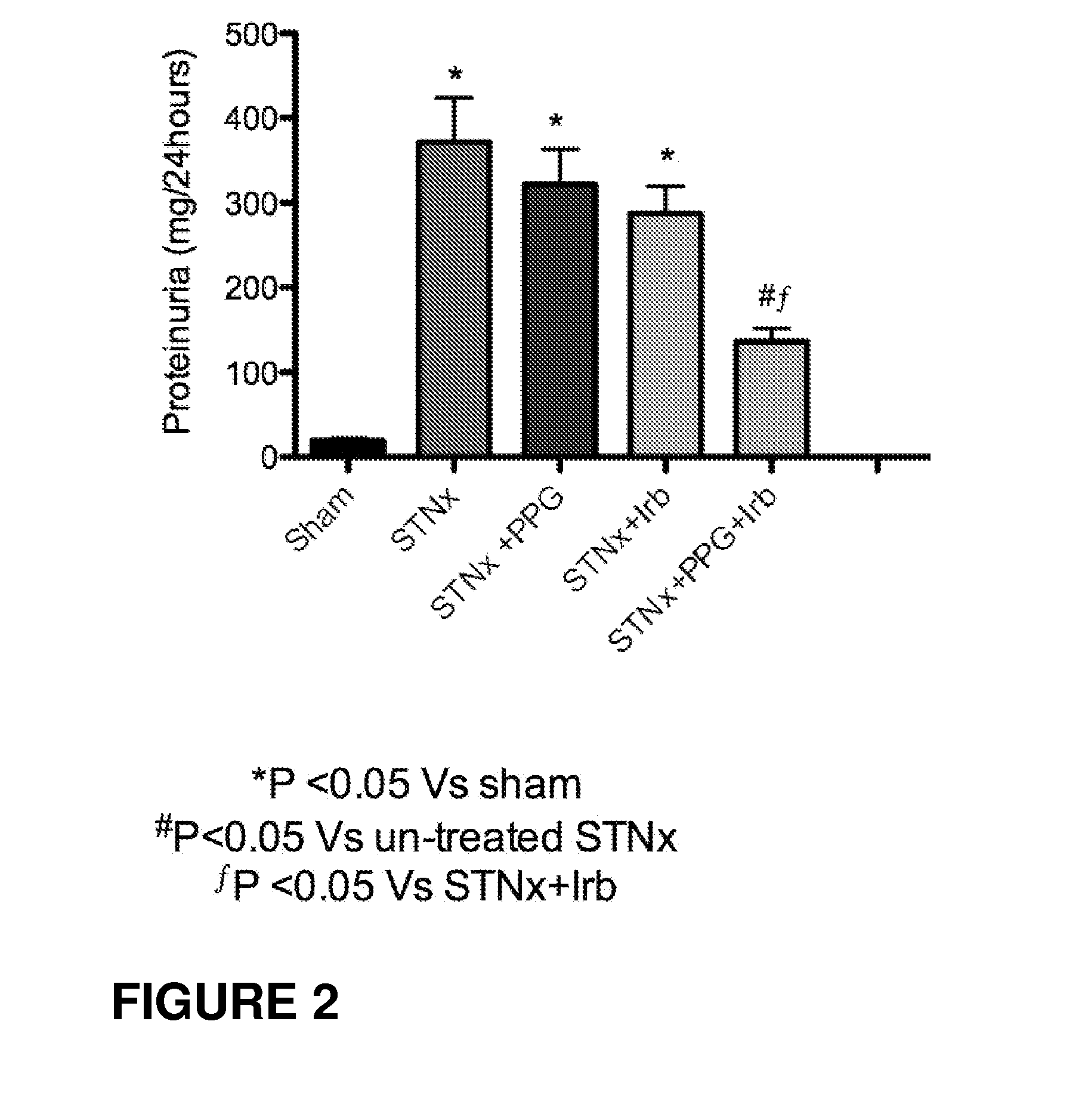Combination therapy
a technology of conjugation therapy and cytokine, which is applied in the field of conjugation therapy, can solve the problems of insufficient validation of human diabetic nephropathy therapies, dysfunctional chemokine system, and depletion of immune response, and achieve the effects of preventing, treating, and preventing a condition
- Summary
- Abstract
- Description
- Claims
- Application Information
AI Technical Summary
Benefits of technology
Problems solved by technology
Method used
Image
Examples
example 1
Reduction of Proteinuria in STNx Model (Low Dose Propagermanium)
Sub-Total Nephrectomy (STNx) Surgery
Animal
[0227]Six weeks old, male Sprague-Dawley (SD) rats weighing 200-250 g are sourced from Animal Resources Centre (Western Australia). The animal study is conducted with the approval from the Animal Ethics Committee (St Vincent's Hospital and the National Health and Medical Research Foundation of Australia). All rats receive normal rat chow (Certified Rodent Diet #5002, LabDiet, USA) and drinking water ad libitum. All animals are housed in a stable environment maintained at 22±1° C. with a 12-hour light / dark cycle commencing at 6 am. STNx surgery is performed in operating theater at St Vincent's Experimental Surgical Unit. All surgical procedures are modified from those previously described (Gilbert, R. E., L. L. Wu, et al. (1999). “Pathological expression of renin and angiotensin II in the renal tubule after subtotal nephrectomy. Implications for the pathogenesis of tubulointersti...
example 2
Reduction of Proteinuria in STNx Model (High Dose Propagermanium)
[0258]As described for Example 1 but with the following treatments:
Study Design and Procedures
[0259]Treatments start 14 days following surgery.
[0260]Long term (12 weeks)[0261]Untreated groups
[0262]Groups 1, 2 Untreated: Control, Diabetic[0263]Single agent group
[0264]Group 3 STNx+Irbesartan (ARB) (10 mg / kg / day) or STNx+Propagermanium (30 mg / kg / day)[0265]Combination group
[0266]Group 4 STNx+Irbesartan (10 mg / kg / day) / Propagermanium (30 mg / kg / day)
[0267]n=16 rats per group
[0268]As shown in FIG. 2, improved levels of proteinurea were achieved in the sub-total nephrectomy (STNx) model of end organ renal disease when animals were treated with a combination of an angiotensin receptor blocker and a high dose of propagermanium (STNx+PPG+lrb) as compared to untreated STNx animals, STNx animals treated with a high dose of propagermanium alone (STNx+PPG), and STNx animals treated with the angiotensin receptor blocker alone (STNx+Irb)...
example 3
Upon Co-Expression of AT1R and CCR2 via Transient Transfection of HEK293FT Cells, Combined Inhibition of Both Receptors Blocks Arrestin Recruitment to a Greater Extent than Inhibition of Either Receptor Alone
[0270]The combined effect of CCR2 and AT1R inhibition in vitro was investigated by using RS504393 in combination with Irbesartan.
[0271]FIG. 5 shows the effect of AT1R and CCR2 blockade on β-arrestin2 recruitment. HEK293FT cells were transiently transfected with plasmids coding for β-arrestin2-Venus and the indicated receptors: CCR2-Rluc8 (top panel), AT1R-Rluc8 (middle panel) or AT1R-Rluc8 and the untagged CCR2 (bottom panel).
[0272]Cells were harvested 24 h post-transfection in HEPES-buffered phenol red-free complete medium containing 5% FCS and added to a poly-L-lysine-coated white 96-well plate. 48 h post-transfection, the plate was incubated at 37° C., 5% CO2 for 2 hours with 30 μM EnduRen (Promega) to ensure substrate equilibrium was reached.
[0273]Cells were first pre-incuba...
PUM
| Property | Measurement | Unit |
|---|---|---|
| pH | aaaaa | aaaaa |
| particle size | aaaaa | aaaaa |
| particle size | aaaaa | aaaaa |
Abstract
Description
Claims
Application Information
 Login to View More
Login to View More - R&D
- Intellectual Property
- Life Sciences
- Materials
- Tech Scout
- Unparalleled Data Quality
- Higher Quality Content
- 60% Fewer Hallucinations
Browse by: Latest US Patents, China's latest patents, Technical Efficacy Thesaurus, Application Domain, Technology Topic, Popular Technical Reports.
© 2025 PatSnap. All rights reserved.Legal|Privacy policy|Modern Slavery Act Transparency Statement|Sitemap|About US| Contact US: help@patsnap.com



